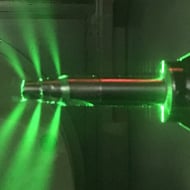Welcome! Here are the website rules, as well as some tips for using this forum.
Need to contact us? Visit https://heatinghelp.com/contact-us/.
Click here to Find a Contractor in your area.
Non water transfer fluids?
Options
Comments
-
This product was used in a bunch of solar thermal around here.
Stains the roofing shingles for life and makes for a messy hard to clean up concrete spill Bob "hot rod" Rohr
Bob "hot rod" Rohr
trainer for Caleffi NA
Living the hydronic dream0 -
If you've got the money, honey... the trick if you are using vapour phase heat transfer (that is, using the latent heat of evaporation for most of your energy transfer, if not all of it) is to find a fluid which has a boiling point in the range(s) you want at pressures you can live with. It's nice if the specific heat of evaporation is nice and high -- minimizes the volume of fluid (vapour or liquid phase) which you have to deal with.
I would think some of those fluids might be quite handy in concentrating solar collectors.
On the other hand, water is pretty good at what is needed... and cheap.Br. Jamie, osb
Building superintendent/caretaker, 7200 sq. ft. historic house museum with dependencies in New England0 -
-
This discussion reminded me of a little fiasco years ago just down the road from me in Piqua—cooling a nuclear reactor with terphenyl instead of good ‘ol light water. The advantages are a higher boiling point/lower pressure/less neutron capture (higher efficiency, less fuel enrichment, blah-blah-blah)
Turns out, the neutron bombardment made the unconventional organic coolant turn into viscous polymerized buggers that clogged things up. This doomed the entire project after only a few years of operation. Whoops!0 -
I recall reading some instructions for the early internal combustion farm tractors, they were refereed to as "Oilers".
I assume that name was used because they burned some form of petroleum versus wood or coal for a steam engine.
For the cooling system which was simple gravity flow with no water pump, you could use honey. I guess as it heated and became fluid it would eventually flow up to and thru the radiator.
So this would be an early form of "phase change" coolant.
Ants would show you where any leaks were. 0
0
Categories
- All Categories
- 87K THE MAIN WALL
- 3.2K A-C, Heat Pumps & Refrigeration
- 57 Biomass
- 425 Carbon Monoxide Awareness
- 112 Chimneys & Flues
- 2.1K Domestic Hot Water
- 5.7K Gas Heating
- 106 Geothermal
- 160 Indoor-Air Quality
- 3.6K Oil Heating
- 70 Pipe Deterioration
- 979 Plumbing
- 6.3K Radiant Heating
- 388 Solar
- 15.4K Strictly Steam
- 3.4K Thermostats and Controls
- 54 Water Quality
- 44 Industry Classes
- 48 Job Opportunities
- 18 Recall Announcements



